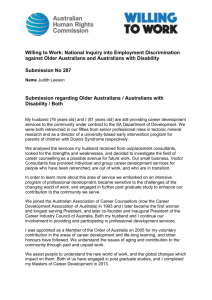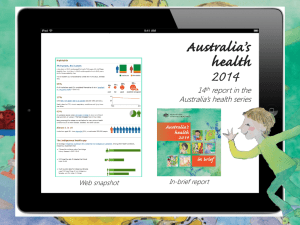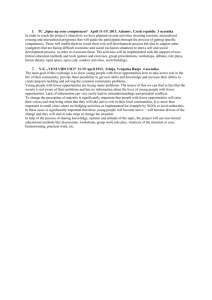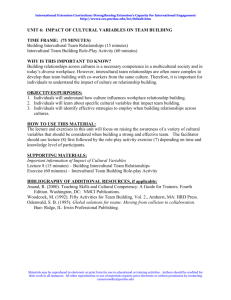Melbourne Declaration on Educational Goals for Young Australians
advertisement
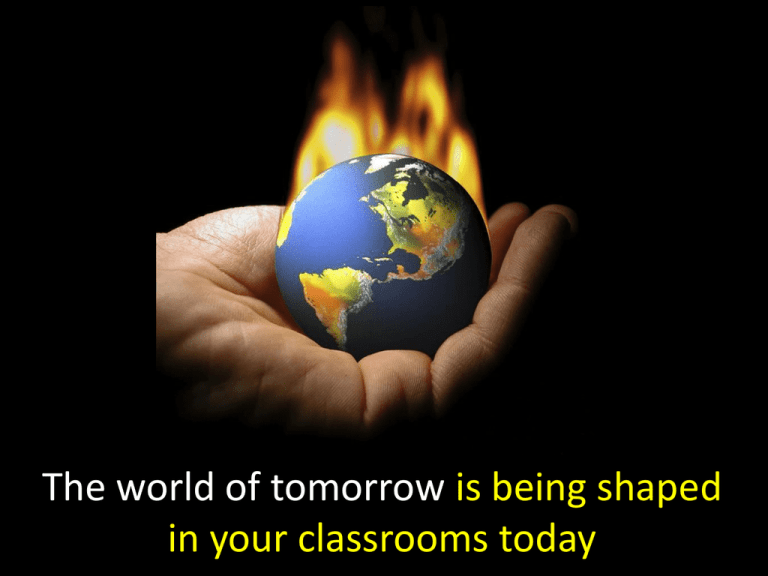
The world of tomorrow is being shaped in your classrooms today Melbourne Declaration on Educational Goals for Young Australians (MCEETYA 2008) Major changes in the world: rapid global integration and international mobility environmental, social and economic pressures extend beyond national borders requiring countries to work together in new ways Indonesians & Australians: main fear? Australia The breakup of Aus/Ind 27% 0% Damage to your religion 13% 1% 13% Terrorist attack The breakdown of law and order or social harmony in Aus/Ind 17% 12% Another country promoting dissent in Aus/Ind Another country attacking Aus/Ind 5% 3% 5% Epidemics or diseases Indon No1 worry: Separatists. (And Aussie “meddling”) Aussie No1 worry: Climate. (Not enough Indons care). 7% 5% 5% Loss of energy resources 4% 4% Large scale nuclear war 3% Oppression by your own government 17% 9% 5% 5% 2% Climate change 1% Damage to your values 0% Indonesia 24% 4% 5% 10% 15% 20% 25% Source: Roy Morgan Research, August 2008 30% World Language Families Asian Languages 2010 • 18% of Australian school students currently study an Asian language – down from 23% in 2002 • Decreases to 5.8% in Year 12 - down from 6.6% in 2008 • 94% of year 12 students of Chinese have Chinese background • Indonesian is losing 10,000 students per year since 2005 • Japanese declined 20% - now mostly in primary schools • Korean taught in very few schools. Four Languages, Four Stories: the Current State of Japanese, Chinese, Indonesian and Korean Languages Education in Australian Schools, AEF, 2010 Atlas of Faiths Year 12 Modern History Typically, Modern History includes many opportunities for an Asian focus – however most students don’t choose them. In NSW Modern History, National Studies module: • 2% chose China • 4% chose India, Japan, Indonesia and Australia combined • 4% - South Africa • 6% - USA • 65% - Germany • 19% - Russia/Soviet Union ACER study on the proportion of Year 12 students studying about Asia in English, History, Geography, International Studies, Politics and Art. Year 12 VCE English The prescribed texts for Literature (40 texts) contains 4 texts with Asian focus or content: • • • • Pearl Buck: The Good Earth William Dalrymple: City of Djinns Andrew X Pham: Catfish and Mandala Michelle de Kretser: The Hamilton Case Neither of the 2 texts available for examination (The Hamilton Case (Novel) & City of Djinns (Other Literature) is mentioned in the Examiners’ Report. The Great Gatsby (Scott Fitzgerald) was the most popular choice in the Novel section. Studies of Asia in Year 12, Australian Council for Educational Research, April 2009 PricewaterhouseCoopers Melbourne Institute Asialink Index www.asialink.unimelb.edu.au Melbourne Declaration on Educational Goals for Young Australians ‘India, China and other Asian nations are growing and their influence on the world is increasing. Australians need to become ‘Asia literate’, engaging and building stronger relationships with Asia…’ ‘Asia literacy’ is foundational and deep knowledge, skills and understandings about the histories, geographies, societies, cultures, literatures and languages of the diverse countries that make up our region. Melbourne Declaration on Educational Goals for Young Australians Goal 1 Equity and Excellence: schooling contributes to a socially cohesive society Goal 2 Successful learners: able to make sense of their world Confident and creative individuals: have a sense of self worth and identity; relate well to others Active and informed citizens: appreciate Australia’s social, cultural and linguistic diversity; communicate across cultures especially Asia; act as responsible global and local citizens Australian Curriculum Asia and Australia’s engagement with Asia: priority for all students Intercultural Understanding: required by all students ACARA: Asia and Australia’s Engagement with Asia Organising Ideas • The countries of Asia have grown in political, environmental, cultural, economic and strategic importance for Australia, the region and the world. • The peoples and countries of Asia are diverse in ethnic background, traditions, culture, belief systems and religions. • The achievements of the people and countries of Asia contribute to world history and human endeavour past and present. • The countries of Asia have diverse environments and the ongoing interactions between these environments and human activity have influence locally, regionally and globally. Year 12 English student draws on contemporary politics and traditional Indonesian culture Year 10 student learns Balinese dance in Performance Arts Year 3 student participates in ICT Teddy Bear exchange with school in Pakistan. Year 6 Music student learns Taiko drumming Skills, Knowledge, Understandings Students Teachers ICT: wikispaces, skype, web, ICT: wikispaces, skype, web, mobile mobile telephony, smart boards telephony, smart boards & blending ICT into classroom pedagogy Subject knowledge and skills Subject knowledge and skills to frame learning sequence Communication: language & intercultural skills Communication: language & intercultural skills to guide student to student interaction & collaborate with teacher partner Values: curiosity, openness, friendship & intercultural understanding Incentive: student outcomes, friendship & intercultural understanding Achieving Asia literacy & intercultural understanding requires systemic leadership & support • Education leaders: champions • Curriculum frameworks: explicit • Monitor & report: intercultural dimension; Asia literacy • Curriculum resources: available & relevant • ICT: link teachers and students across the world • Teacher professional learning: available & in-depth • Teacher education: intercultural & Asia dimension • School leaders : supported to lead change • Parents and school communities: support/demand • Languages: essential www.deewr.gov.au/schooling/nalssp Asia Education Foundation Established in 1992 AEF vision: an Australia where all citizens confidently and actively engage with the people, countries and cultures of Asia, both within and outside Australia AEF mission: through education, to equip young Australians with knowledge, skills and understandings of the people, countries and cultures of Asia. Asia Literacy 21st Century reality for all young Australians • Globalisation: connected people • Global issues: connected countries • Rise of Asia: Asia and Australia = new skills, knowledge, understandings
